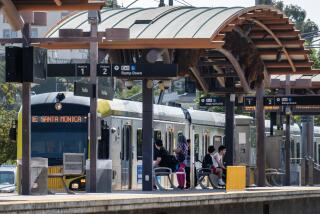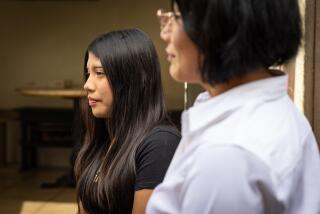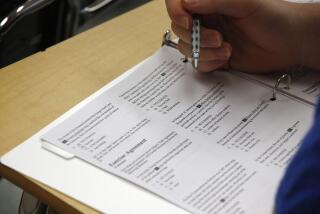Officials Go to School to Solve Bus Problem : Transportation: Student ignorance and safety concerns top list of reasons why students do not use public transit.
- Share via
THE REGION — A team of Foothill Transit representatives is visiting 19 San Gabriel Valley high schools and colleges to find out why students are not riding the bus.
The visits are a follow-up to a transit poll of 1,200 students in October showing that 67% do not ride Foothill buses and 48% do not use public transportation.
At Sierra Vista High School in Baldwin Park, the first of the campus visits earlier this month, a group interview with a dozen students identified the main reason as ignorance: most were completely uninformed about the San Gabriel Valley bus system.
“I had no idea you could take the bus to the mall,” said junior Aristotle Rivera, 16. Other students echoed Rivera’s surprise when they learned about Foothill Transit’s 85-cent fare and discovered a stack of bus schedules gathering dust in the main office of the school.
Female students surprised the Foothill team when they said safety concerns were another reason why they do not ride the bus. Safety issues never surfaced on the survey of campuses from Pasadena to Pomona, and Foothill has not had a violent incident occur on its buses since they began running in 1988, said Joyce Baner, director of marketing and communications.
“With all the shootings in New York and such, my mom worries a lot about me going somewhere on a bus,” said senior Gloria Almanza, 17. “My mom always says she’d rather pick me up and take me somewhere, even when she’s sick, than have me ride the bus alone.”
Poor lighting at stops also scared a number of female students away from the bus.
“I get worried sometimes when I ride the bus. You guys may laugh,” said junior Katrina Van Oosten, 15, as she looked at the smiling males sitting around her. “But how many guys get hassled waiting for the bus? Some of the stops aren’t well-lit, and I get scared waiting out there in the dark.”
Shorter waits and more information about schedules and fares topped the survey’s list of suggestions to increase student ridership on Foothill Transit. The poll revealed that students do not take the bus because 83% either car-pool, drive alone or walk to school every day.
Only 7% take a blue-striped Foothill Transit bus or a yellow school bus to get to class, although the vast majority of students who rode Foothill buses rated their experience as “good” or “excellent.”
Six percent said they do not ride because they do not want their friends to see them on the bus, a figure far lower than transit officials expected. “We thought riding the bus was not ‘cool’ with these kids,” Foothill spokesman Jeffrey Fox said.
The campus visits are part of Foothill Transit’s plan to recruit more student riders, Fox said. He said the results of the survey and a summary of the interviews will be presented to city councils across the San Gabriel Valley, the Metropolitan Transportation Authority and the Los Angeles County Board of Supervisors in March or April.
“This is our effort at being more responsive to the community,” Baner said. Lobbying cities for more funding or expanding Foothill Transit’s operations were not considerations in conducting the survey, she said. Foothill spent $5,000 on the survey.
“Getting more money for transit could be a side benefit, but it was not the goal of this survey,” Baner said. “We wanted to find out what this market segment feels and thinks about transit. These are the people who need transit. They don’t drive yet . . . and these are our future commuters. We want them to grow up seeing public transportation as an option.”
The half-hour session gave the Foothill Transit team plenty of ideas. “It really surprised me that they didn’t know about the $12-a-month high school pass, the bus books in the front office and the 800 number we have to get bus times and information,” Baner said.
The $12 pass gives unlimited rides for one month.
Foothill Transit may consider handing out wallet-sized cards printed with bus information to students at every high school and college in its service area, Fox said.
“The whole process shows it’s been a long time since any of us have been to high school,” he said. “We’re doing this to get feedback, we don’t necessarily know what these kids want anymore.”
More to Read
Sign up for Essential California
The most important California stories and recommendations in your inbox every morning.
You may occasionally receive promotional content from the Los Angeles Times.










